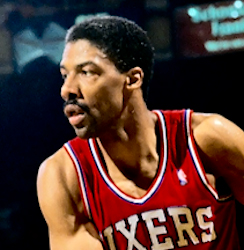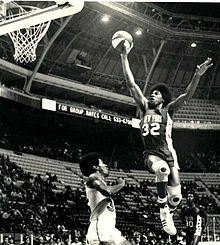Julius Erving
| Julius Erving | ||

|
||
| Player information | ||
|---|---|---|
| Full name | Julius Winfield Erving II | |
| Nickname | Dr. J | |
| birthday | 22nd February 1950 (age 70) | |
| place of birth | East Meadow, New York , USA | |
| size | 201 cm | |
| Weight | 91 kg | |
| position | Small forward | |
| college | Massachusetts | |
| NBA draft | 1972, 12th pick , Milwaukee Bucks | |
| Clubs as active | ||
| 1971-1973 |
|
|
| 1973-1976 |
|
|
| 1976-1987 |
|
|
Julius Winfield Erving II (born February 22, 1950 in East Meadow , New York ), also Dr. Called J , is a retired American basketball player . He is considered one of the best small forwards in the history of the professional leagues ABA and NBA . With his game he laid the foundation for the development of a more athletic and spectacular form of sport. He was one of the first "flyers" of the NBA, a jumping miracle that played his opponents in the air instead of on the ground. In 1993, Erving was inducted into the Naismith Memorial Basketball Hall of Fame .
Career
College and ABA
In his last two years as a Forward at the University of Massachusetts , Erving had a sensational 26.3 points and 20.2 rebounds per game. The interest of the NBA clubs in Erving was initially low, so he decided in 1971 to finish his studies. He signed a contract with the ABA team Virginia Squires . At that time the ABA was the competition league of the NBA and discussions about a merger of the two leagues have recently been held.
In his first season, Erving gave the first taste of his skills. He scored an average of 27.3 points per game and had to admit defeat to Artis Gilmore in the election for rookie of the year . The Squires moved into the Eastern Division Finals, but failed because of the Rick Barry- led New York Nets . In the summer of 1970 Erving's student days ended and he was automatically registered for the NBA draft. And although the Milwaukee Bucks picked him 10th, Erving had to stay with the Squires because of his contract. Erving accepted the situation and focused fully on his game.
When he won the ABA scoring title the following season, he realized that he was now the most dominant player in the ABA and he set higher goals. Before the 1973/74 season, Erving came through a trade with the Nets in New York, the ideal show stage for the superstar. He led the Nets straight away to the title and was voted Most Valuable Player (MVP) the following year .
In the 1976 ABA Finals, Erving and the Nets beat the Denver Nuggets , winning their second championship in three years. As it turned out shortly afterwards, this was the last endgame in the history of the ABA.
The NBA wanted to bring the crowd puller Julius Erving into the league at all costs. But since he was still contractually bound to the Nets, the solution to the problem was agreed to merge the leagues. The Nets, Denver Nuggets, Indiana Pacers and San Antonio Spurs were inducted into the NBA, and the rest of the ABA players were divided among the teams in an expansion draft .
Julius Erving was elected ABA MVP three times in a row between 1974 and 1976. He was also nominated for the All Star First Team four times in a row between 1973 and 1976 .
NBA
Contract problems forced the Nets to deliver Erving to the Philadelphia 76ers in a lightning transfer shortly before the start of the 1976/77 season . Erving, who recognized the situation in his new team, decided to put himself more in the service of the team. The Sixers fought their way through the playoffs and advanced to the finals against the Portland Trail Blazers . There they failed because of the blazers around center legend Bill Walton , who decided the series after six games and were crowned champion.
The management of the Sixers then began to build a team around Erving. Reinforced by Maurice Cheeks and Bobby Jones , the Sixers moved into the finals twice in the following three years, but failed both times at the Los Angeles Lakers . Apparently a dominant center was missing to win the championship, which could prevail against Robert Parish of the Celtics and Kareem Abdul-Jabbar of the Lakers. So for the 1982/83 season they brought in the best the NBA had back then - league MVP Moses Malone .
After a demonstration of strength in the playoffs, they finally moved into the finals and met defending champion LA Lakers, who has now mutated into feared opponents. With a sweep (4: 0) and winning the title, the Sixers were finally compensated for the disappointments of the previous years. After winning the title, the era of Julius Erving and with it that of the Sixers came to an end after many years at the top of the NBA. In 1984 the competition with Larry Bird culminated in a fight between the two during a game.
After the 1986/87 season , Erving resigned from professional sports at the age of 37. During his NBA career, he was voted NBA Most Valuable Player once (1981) and five times to the All NBA First Team (1978, 1980, 1981, 1982, 1983), and eleven times in a row between 1977 and 1987 All-Star -Team appointed. In 1977 and 1983 he was elected MVP of the All Star Games. Also in 1983, Erving received the J. Walter Kennedy Citizenship Award for social commitment. In 1993 he was inducted into the Naismith Memorial Basketball Hall of Fame .
Later, Dr. J worked as a commentator and successful businessman until he returned to the NBA league in 1997 as Vice President of Orlando Magic .
literature
- James Haskins: Doctor J .: A Biography of Julius Erving , Garden City (NY) 1975. ISBN 0-385-09905-3
See also
Web links
- Julius Erving - player profile on NBA.com
- Julius Erving - player profile on basketball-reference.com
- Julius Erving in the Internet Movie Database (English)
- Julius Erving in the Naismith Memorial Basketball Hall of Fame On: Hoophall website; Springfield, MA, 2017. Retrieved November 8, 2017 (in English).
Individual evidence
- ↑ Julius Erving. In: NBA.com. Retrieved May 5, 2020 .
- ↑ a b The Naismith Memorial Basketball Hall of Fame :: Julius Erving. In: hoophall.com. Retrieved May 5, 2020 .
- ^ Julius Erving breaks down his legendary fight with Larry Bird . In: For The Win . May 3, 2018 ( usatoday.com [accessed July 9, 2018]).
| personal data | |
|---|---|
| SURNAME | Erving, Julius |
| ALTERNATIVE NAMES | Erving, Julius Winfield II (full name); Dr. J (nickname) |
| BRIEF DESCRIPTION | American basketball player |
| DATE OF BIRTH | February 22, 1950 |
| PLACE OF BIRTH | East Meadow , New York , United States |

